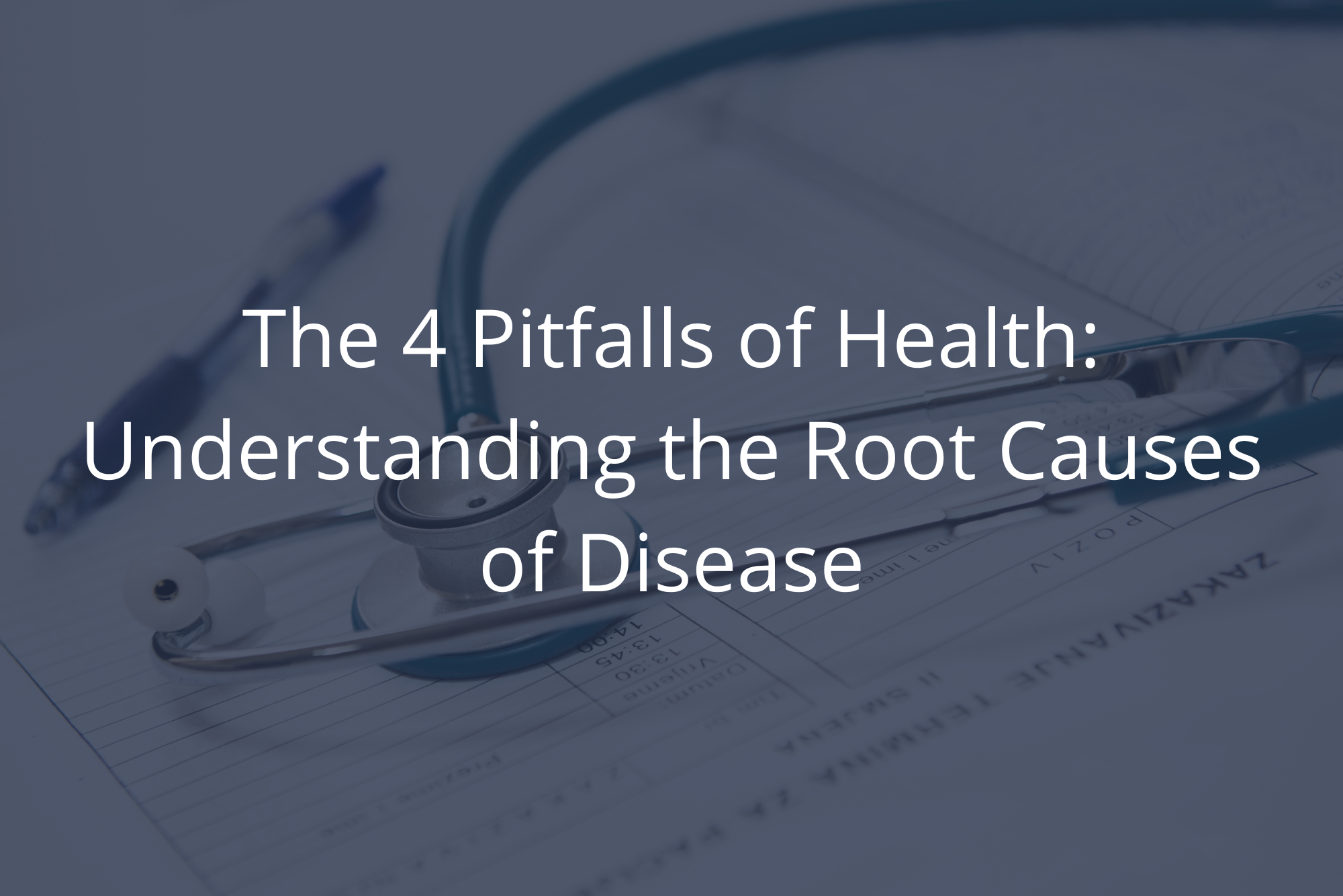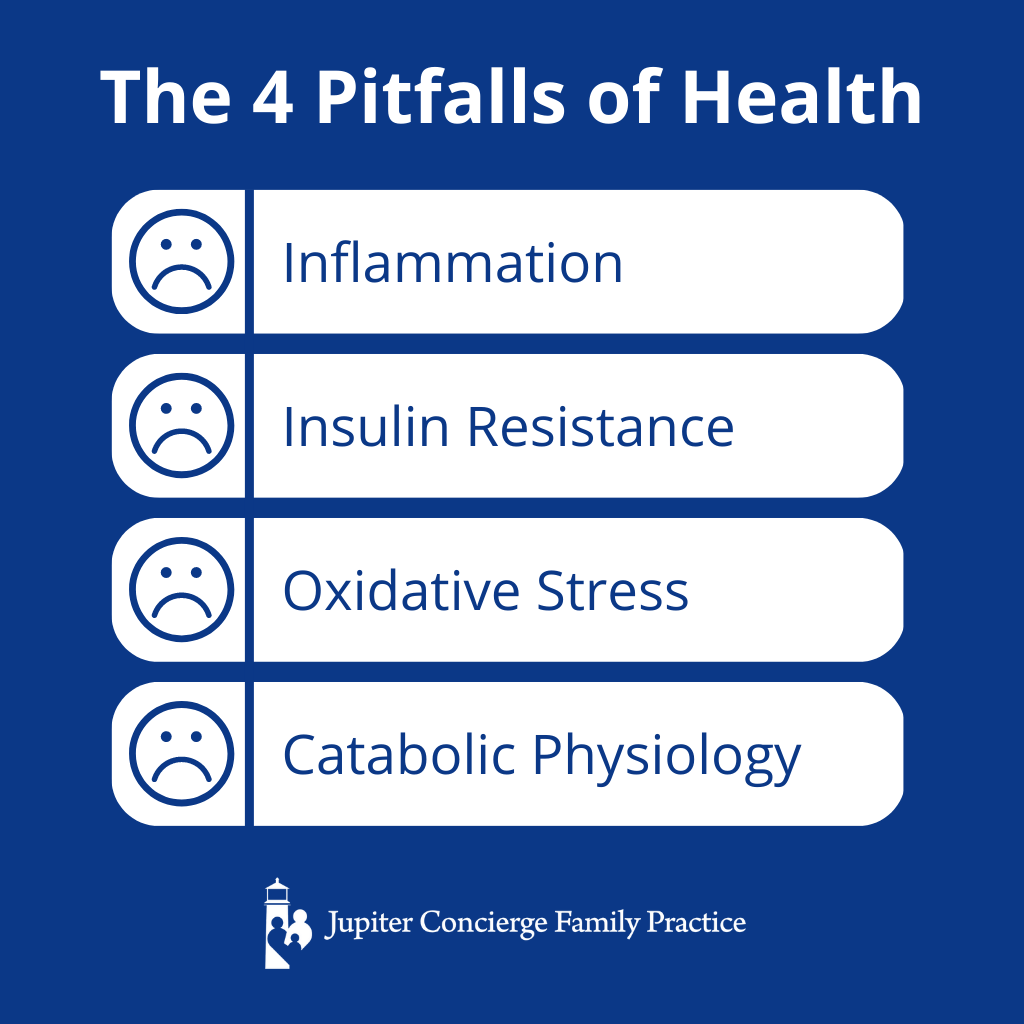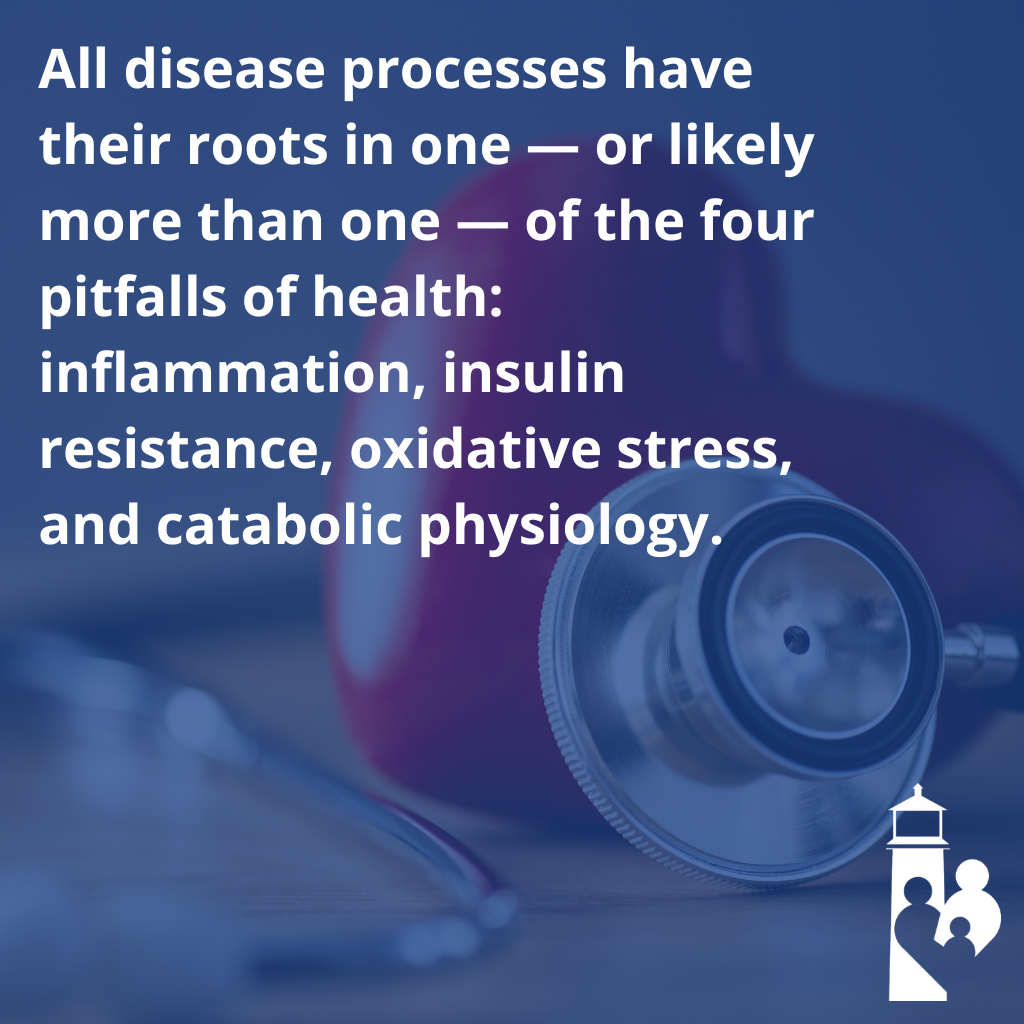 If you’re a regular reader of my blog, you know I often focus on the four pillars of health — sleep, exercise, nutrition, and stress elimination. Today, I want to change the lens and talk to you about the four pitfalls of health.
If you’re a regular reader of my blog, you know I often focus on the four pillars of health — sleep, exercise, nutrition, and stress elimination. Today, I want to change the lens and talk to you about the four pitfalls of health.
One of the main goals of medicine is to prevent disease. In order to fully understand how to do that, we have to first understand where disease comes from.
What Is Disease, Anyway?
Disease is the end result of dysfunction. Although the rare individual may be born medically compromised in some way, people are not typically born with disease. More often, we’re born with genetic predispositions to certain disease processes, and/or our lifestyles disrupt the balance of our bodily functions.
Though the total number of diseases is incalculable, almost all disease is rooted in the following four dysfunctions: inflammation, insulin resistance, oxidative stress, and catabolic physiology. Concentrating on the repair and treatment of these four causes makes disease less likely to occur.
The 4 Pitfalls of Health
Before I explore each pitfall and how it contributes to disease, I want to acknowledge that this preventative approach is foundational to functional medicine. Thinking about these underlying causes as systems-based (not organ-based) is part of how functional medicine works. To treat a heart condition, for instance, you first need to inspect what’s causing the heart problem.
Because everything that happens in the body affects everything else that happens in the body, we can’t separate dysfunction and disease from the whole. The organs work in collective systems, and some functions are found in multiple organs. Think, for example, about the immune system. From 60 to 70% of the immune system is found in our intestines, but it’s also found in our bone marrow and blood.
Pitfall #1: Inflammation
Inflammation itself is a physiological process — not a pathological one. This means we need a certain amount of inflammation in order to be healthy. It’s completely necessary and normal. But too much inflammation leads to disease processes.
Inflammation causes blood vessels to dilate, bringing oxygen and nutrients to the affected tissue. This aids in the healing process and helps fight infection, though it also leads to short-term swelling and irritation. Think about scraping your knee as a child, and what it looked like a few hours later.
This sounds like a good thing, and it is… at first. Over time, though, inflammation becomes destructive. Sustained levels of inflammation cause the breakdown of structures, and it can lead to permanent damage. Unlike a skinned knee that soon clears up, long-term inflammation gives, say, a football player arthritic knees.
Other problems caused by inflammation include stomach ulcers and bleeding (from too much alcohol), and various types of cancer.
In a nutshell, inflammation is a normal, short-term process that aids in healing, but long-term inflammation is problematic and leads to osteoarthritis, stomach ulcers, and/or cancer.
Pitfall #2: Insulin Resistance
Insulin is a naturally occurring bodily hormone that transports glucose (sugar) to the cells. Although we may think of sugars as harmful, glucose is of utmost importance for cell survival. In fact, the brain depends on sugar as its main fuel.
When insulin works efficiently, the body’s need for glucose is well-regulated. But because this process is elegant and complex, there are many ways it can be interrupted.
Insulin becomes less effective in excess. Like any tolerance issue, the more there is of a substance, the less we respond to it, and a higher amount is required to create the desired effect. When our cells stop responding to insulin, the body produces more of it. This process leads to inflammation, which, as you already know, incites a whole host of problems.
Typically, overconsumption of simple sugars — junk food, in other words — creates excess insulin. When there’s too much sugar in the bloodstream, the pancreas jumps into action to secrete insulin and move that glucose out of the blood and into cells. If the insulin isn’t able to effectively transport the glucose, the pancreas makes more.
In a nutshell, insulin resistance means the body stops responding to insulin, a hormone that helps transport sugar into cells, which causes insulin production to increase. Since insulin is pro-inflammatory, this can result in higher risk for diabetes, heart disease, obesity, and/or stroke.
 Pitfall #3: Oxidative Stress
Pitfall #3: Oxidative Stress
I like to illustrate oxidation using the image of an apple.
If you cut apple slices in the morning and pack them in a lunchbox, they’ll be brown by noon. That’s oxidation. But if you squeeze a little lemon juice on your cut-up apple, it will retain its color. That’s because vitamin C, contained in lemons, is an antioxidant and therefore prevents oxidation.
Oxidation is, essentially, the rotting of anything. That may sound a little gross, but oxidation is normal and necessary. Because bodies are alive, they need to eliminate waste.
Problems show up when the byproducts of oxidation, free radicals, start wreaking havoc. Left unchecked, free radicals can damage the lining of arteries, leading to cholesterol and plaque buildup.
Antioxidants prevent this buildup the same way silicone lining the inside of a pipe prevents waste from sticking. For the body to function correctly, it needs a balance of free radicals and antioxidants. If not, oxidative stress may occur and cause diabetes, heart disease, stroke, and dementia.
Fortunately, we have an excellent source of antioxidants: highly pigmented fruits and vegetables.
In a nutshell, oxidative stress is when the body’s response to free radicals creates problems like plaque buildup, diabetes, heart disease, stroke, and dementia.
Pitfall #4: Catabolic Physiology
The body is constantly building up and breaking down, e.g. building up muscle and breaking down nutrients, over and over. It’s how we stay alive. In medical terms, anabolism is the buildup and catabolism is the breakdown.
When there’s more breakdown than buildup, that’s called catabolic physiology.
Neglecting the four pillars of health — sleep, exercise, nutrition, and stress elimination — can lead to catabolic physiology. For example, in nutrition’s case, not eating high-quality fats can lead to poor cell membrane health, and eating too many simple sugars can lead to increased inflammation and tissue destruction — more catabolism than anabolism.
Catabolic physiology can yield multiple results. One is osteoporosis, the breakdown of bone. Our body is constantly depositing and depleting calcium, and when there’s too little buildup and too much breakdown, osteoporosis occurs.
Here’s what catabolic physiology can yield elsewhere in the body:
- Degenerative joint disease
- Brain atrophy
- Skin thinning
- Leaky gut
In a nutshell, catabolic physiology occurs when the body’s buildup/breakdown equation becomes imbalanced, leading to degenerative diseases such as osteoporosis, brain atrophy, thin skin, and a leaky gut.
The 4 Pitfalls of Health: Conclusion
All disease processes have their roots in one — or likely more than one — of the four pitfalls of health: inflammation, insulin resistance, oxidative stress, and catabolic physiology.
 There are many counterbalancing strategies available in the four pillars of health. Luckily, they’re mostly common sense. In fact, you can use the acronym SENSE to help you remember the four pillars: Sleep, Exercise, Nutrition, and Stress Elimination. Tend to those, and most disease processes can be contained, reversed, or avoided altogether.
There are many counterbalancing strategies available in the four pillars of health. Luckily, they’re mostly common sense. In fact, you can use the acronym SENSE to help you remember the four pillars: Sleep, Exercise, Nutrition, and Stress Elimination. Tend to those, and most disease processes can be contained, reversed, or avoided altogether.
